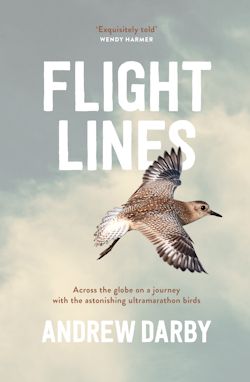SEJournal Online is the digital news magazine of the Society of Environmental Journalists. Learn more about SEJournal Online, including submission, subscription and advertising information.
BookShelf: “Flight Lines: Across the Globe on a Journey With the Astonishing Ultramarathon Birds”
By Andrew Darby
Allen & Unwin, $27.95
Reviewed by Melody Kemp
 |
A scenic walk along the boardwalk of eastern Australia’s Boondall Wetlands on the outskirts of Brisbane recently revealed the last of the season’s grey plovers.
Gathering and fluttering on the receding tideline, almost too far away to see, those tiny shorebirds are usually gone by March or April. But this year’s warm weather might have encouraged them to stay longer.
And after reading Andrew Darby’s book, “Flight Lines: Across the Globe on a Journey With the Astonishing Ultramarathon Birds,” I am totally enthralled by these seemingly insubstantial creatures.
Darby describes them as weighing no more than “two tablespoons of sugar,” and — after summering in the Southern Hemisphere — reaching the obese total of “two tablespoons of butter.”
They accumulate fat from sand bar mollusks and worms in order to fuel their epic migration each year to areas in China, Japan, Siberia or the Arctic. Birds that are underweight simply fall exhausted into the sea and die.
‘Free spirits moving endlessly to feed and roost’
Darby’s book is a love story of sorts or maybe an opera, as the tragedy is as evident as the romance.
Scientists tell him “we have sighted your bird,” like they would alert him to having seen one of his children.
Ornithologist Mark Barter tried explaining why he is fascinated by shorebirds even when there is a gale blowing and he is up to his ankles in mud.
Shorebird numbers are rapidly dropping. …
Birders who care about these delicate
miracles fear devastation lies ahead.
“The best answer I have come up with is because they are such free spirits living in some of the most beautiful places on Earth, moving endlessly to feed and roost as the moon dictates the ebb and flow of the tide … and the harmony of the sun,” he said.
But shorebird numbers are rapidly dropping and some species face extinction. Birders who care about these delicate miracles fear devastation lies ahead.
Hunting and poor land use are two major drivers of shorebird losses. In China and South Korea, for instance, the conversion to industrial estates has severely reduced their nesting habitats and feeding grounds.
Another example Darby mentions is an important nesting and feeding ground near where I am living in Brisbane. Threatened by a large housing and marina development within the range of the RAMSAR site, it typifies the domination of capital over nature. The RAMSAR Convention on Wetlands has no power to veto, merely to signify ecological value.
As a veterinarian told me when I was investigating the erosion of koala numbers in Australia: “People love the same high-value coastal habitats as many of our animals, which are powerless to stop development.”
Drawn in by author’s wonderment
Darby is, like me, astounded that something so small can make such distances without stopping. The record for one single non-stop flight has been clocked by banding at over 11,000 kilometers, or 6,835 miles.
Even more amazing is that parents leave their chicks to mature and the chicks then take to the skies with implicit knowledge of where they are heading.
These small birds have been known to fly into storms and navigate complex weather supposedly using the invisible power of Earth’s magnetic fields.
Darby’s writing is understated and fact-based (my only complaint is that the maps provided really don’t give a sense of scale and are under-notated).
Yet I found myself drawn in by his wonderment. Halfway through the book he is diagnosed with terminal cancer, so the book also hangs on his own hope of survival and whether or not he can make the next field trip.
This book changed how I see the natural world. In a time in which COVID-19 has brought the world depression, it revived my sense of wonder.
Melody Kemp is a longtime SEJ member and a freelancer currently located in Australia.
* From the weekly news magazine SEJournal Online, Vol. 5, No. 28. Content from each new issue of SEJournal Online is available to the public via the SEJournal Online main page. Subscribe to the e-newsletter here. And see past issues of the SEJournal archived here.














 Advertisement
Advertisement 



